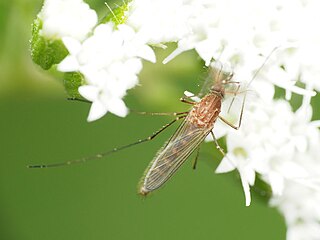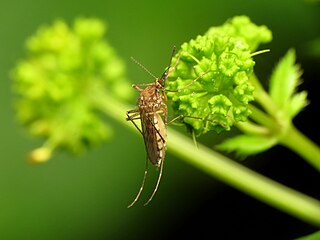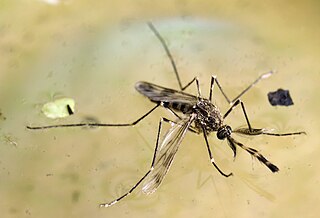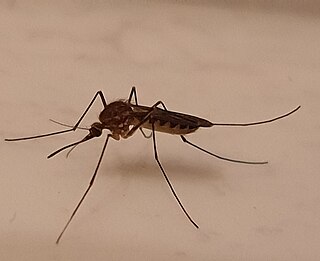
Mosquitoes are approximately 3,600 species of small flies comprising the family Culicidae. The word "mosquito" is Spanish for "little fly". Mosquitoes have a slender segmented body, one pair of wings, one pair of halteres, three pairs of long hair-like legs, and elongated mouthparts.

Aedes albopictus, from the mosquito (Culicidae) family, also known as the (Asian) tiger mosquito or forest mosquito, is a mosquito native to the tropical and subtropical areas of Southeast Asia. In the past few centuries, however, this species has spread to many countries through the transport of goods and international travel. It is characterized by the white bands on its legs and body.

Culiseta is a genus of mosquitoes. Most Culiseta species are cold-adapted, and only occur in warmer climates during the colder parts of the year or at higher elevations where temperatures are lower. Species found in Southern California are larger than most mosquitoes species, specifically Cs. inornata, Cs. particeps, and Cs. incidens. These species are found throughout the year in Southern California and feed on several vertebrate species, such as birds, livestock, rodents, reptiles, and humans. The larvae of most species are found bogs, marshes, ponds, streams, ditches, and rock pools, but an African species occurs in tree holes ("phytotelmata"), a common eastern Palaearctic species occurs in water wells and rock pools, and several Australian species occur under ground. Little is known about the blood-feeding habits of females. Most species feed on birds and mammals, but a few feed on reptiles. Several species attack domestic animals and occasionally humans, and some species are pollinators.

Culex restuans is a species of mosquito known to occur in Canada, the United States, Mexico, Guatemala, Honduras, and the Bahamas. It is a disease vector for St. Louis encephalitis and West Nile virus. In 2013 West Nile Virus positive specimens were collected in Southern California.

Aedes vexans, the inland floodwater mosquito or tomguito, is a cosmopolitan and common pest mosquito. This species has been collected in southern California.

Culex tarsalis, also known as Western Encephalitis Mosquito, is a mosquito species that appears in southern California. The species has black and white banding on the legs.

Culex quinquefasciatus, commonly known as the southern house mosquito, is a medium-sized mosquito found in tropical and subtropical regions of the world. It is a vector of Wuchereria bancrofti, avian malaria, and arboviruses including St. Louis encephalitis virus, Western equine encephalitis virus, Zika virus and West Nile virus. It is taxonomically regarded as a member of the Culex pipiens species complex. Its genome was sequenced in 2010, and was shown to have 18,883 protein-coding genes.
Culex erythrothorax is a species of mosquito that appears in Southern California. It is also known as the tule mosquito due to its preference for breeding in tule plants. The species has a brownish-orange color. It is a confirmed vector of West Nile virus.
Aedes furcifer was named in 1913 as a nomen novum for nigra (Theobald). Aedes furcifer and Aedes taylori have been treated as two species, usually found sympatrically, but are difficult to separate morphologically so the term "Aedes furcifer-taylori group" has been used for the two species, and they have not always been differentiated by workers conducting studies on them.
Aedes bahamensis, also known as Howardina bahamensis, is a mosquito native to the Caribbean and Bahamas, which was first discovered in two counties of southern Florida in 1986,. The females of the species do not require a blood meal to produce eggs, although they will bite if starved of nectar or in order to produce a second brood. They are thought to be capable of transmitting St. Louis encephalitis.
Culiseta novaezealandiae is a species of mosquito. It is endemic to New Zealand. It is found in Southland and Otago. This species was first described by J. S. Pillai in 1966 using specimens collected at Tahakopa. The habitat of this species in its larval stage is coastal broadleaf swamp. It has been hypothesised that the hosts of C. novaezealandiae are birds. This mosquito species is regarded as being unlikely to be an arbovirus vector.

Culex territans is a species of mosquito in the family Culicidae.

Anopheles freeborni, commonly known as the western malaria mosquito, is a species of mosquito in the family Culicidae. It is typically found in the western United States and Canada. Adults are brown to black, with yellow-brown hairs and gray-brown stripes on the thorax. Their scaly wings have four dark spots, which are less distinct in the male.

Culiseta incidens, the cool weather mosquito, is a species of mosquito in the family Culicidae. Specimens have been collected in Southern California.

Culiseta inornata, the winter marsh mosquito, or the unadorned American cool weather mosquito is a species of mosquito in the family Culicidae. This species is found in southern California.

Anopheles franciscanus is a species of mosquito in the family Culicidae. This species has been collected in southern California.
Culex stigmatosoma is a mosquito species that appears in Southern California, Oregon, and Texas. It is a confirmed vector of West Nile virus.
Culex thriambus is a mosquito species that appears in the southwestern United States, including Southern California, Texas, as well as in Mexico. It is a confirmed vector of West Nile virus. The majority of host species the mosquito takes blood from are in the order Passeriformes.
Ernestine Hogan Basham Thurman (1920–1987) was an American entomologist and researcher, focusing on mosquitoes and vector control. In 1951 she was the first woman sent by the United States to Thailand to establish a malaria control program.

Anopheles hermsi is a species of mosquito in the family Culicidae. It is a known vector of Plasmodium vivax malaria. An. hermsi have been collected in Southern California.











